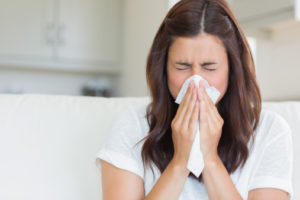 INFLUENZA, an airborne, highly contagious, often lethal viral infection, has the potential for extensive dissemination, local epidemics, even a global pandemic, that can result in widespread death, disability and socio-economic disruption.
INFLUENZA, an airborne, highly contagious, often lethal viral infection, has the potential for extensive dissemination, local epidemics, even a global pandemic, that can result in widespread death, disability and socio-economic disruption.
The virus is spread airborne via sneezing, coughing, spitting, or finger-to-face contact with contaminated objects, e.g., doorknobs.
The germ initially causes toxic symptoms, including fatigue and malaise, fever and chills, aches and pains, headaches and nausea. It targets the upper respiratory tract, causing nasal congestion, blockage and discharge and can be easily confused with the common cold or allergic rhinitis. In the event of a local epidemic, assume that the patient has influenza until otherwise proven.
Complications arise from the spread of the viral agent itself, or from other invading, opportunistic micro-organisms, and include:
1. Pharyngitis – sore throat, with or without tender, swollen neck glands.
2. Sinusitis – frontal headaches, sinus congestion and postnasal drip with irritant coughing and phlegm.
3. Otitis media – earache, decreased hearing, and sensation of ear fullness and crackling.
4. Laryngitis – hoarse voice and having to clear the throat often.
5. Bronchitis – cough with mid-chest soreness and colored sputum.
6. Croup – barking cough, stridor (noisy breathing) and difficulty breathing in.
7. Epiglottitis – excessive drooling of saliva, stridor (noisy breathing) and difficulty breathing in.
8. Bronchiolitis – coughing with wheezing and difficulty breathing out.
9. Pneumonia – spitting up blood, breathlessness, and one-sided chest pain when breathing in.
10. Septicemia – high fever, rigors, extreme weakness, prostration, faintness, shortness-of-breath, cyanosis.
Personal Assessment and Response
Ask the individual: “In the past 10 days, have you been in an area with diagnosed cases of influenza?”
If the answer is “No”, advise: “Keep abreast of the news for flu outbreaks and official advisories in the home and work areas.”
If the answer is “Yes”, advise: “Follow local health advisories, protect yourself, and check periodically for infection.”
Follow local health advisories:
Consult media, public health departments, health care providers, special phone hotlines, text messaging or web sites, regularly.
Protect yourself at all times:
1. Avoid public congregation and unnecessary contact with others, especially in emergency rooms and doctors’ offices.
2. Stay at home as much as possible, stock up with food and supplies, and avoid unnecessary socialization.
3. Tele-commute – conduct occupational affairs online, or by phone, as much as possible, from your home or private office.
4. Wear a mask when in areas where infected people may be present, and avoid individuals with nasal congestion or coughing.
5. Avoid touching contaminated objects and keep your fingers away from your face, especially your eyes, nose and mouth.
6. Wash hands frequently, but avoid public restrooms. Carry and use convenient alcohol-based hand lotions when not at home.
7. Provide antiseptic hand lotions at all entrances to your home, offices and cars, and insist everyone entering use it.
8. Isolate infected individuals. Have them wear surgical masks, use disposable tissues, and limit touching shared objects.
9. Use disinfectants and disposables in treatment facilities. If you enter an area with infected individuals, wear disposable caps, NIOSH N95 masks, gowns and overshoes before entering, and dispose of these in special containers when leaving.
Shed possibly contaminated clothing when you enter your front door, bag and launder them, then shower and shampoo.
The extent to which the client should follow the above ‘ten commandments’ should be dictated by the infectivity, morbidity and mortality associated with the local influenza epidemic, as well as by the individual’s susceptibility and current state of health.
Check periodically for infection:
The human defense mechanisms and immune systems will actively combat microbial infections, but may fail if the virus is particularly virulent, if there are pre-existing chronic conditions, e.g., asthma, emphysema, diabetes, leukemia, immune suppressive therapy, or if there are co-existing acute illnesses, e.g., vomiting and diarrhea.
Use the ‘Specific Triage Guidelines’ to detect influenza syndrome and flu-related complications. Then review the findings, triage suggestions, as well as the diagnostic possibilities above, to determine the urgency of professional consultation, and to describe the illness confidently, in order to get more informed medical responses.
For minor symptoms, one can use over-the-counter medications, and consider preventive vaccines and antivirals, if recommended. Medical attention, including investigations, prescription drugs, even hospital admission, may become necessary, depending on the extent of illness, complications and co-morbidity.
Referring to the numbered ‘complications list’ above, the greater the number, the more urgently one should consider consulting a healthcare provider, preferably by phone, fax or e-mail. Always remember: At any level of expertise, medical decisions are only as good as the amount of information given to the health care provider.
This publication enables anyone to detect complications quickly, determine urgency confidently, and describe illness competently to health care providers, in order to get more accurate professional medical responses – directly in person, or remotely, by telephone, fax, e-mail or text messaging.


